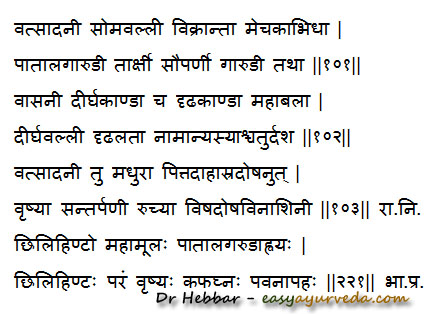Patala Garudi – Cocculus hirsutus Uses, Dose, Research
Patala Garudi – Cocculus hirsutus is an Ayurvedic herb used in treating intestinal worm infestations, Sun stroke, migraine, anorexia etc. It also possesses antimicrobial potential.
Botanical Name- Cocculus hirsutus(Linn) Diels.
Family- Menispermaceae (Guduchi kula)
Table of Contents
Vernacular names
Names in different languages:
Hindi Name- Jalajamani, Patal garudi, Jal jamani, Jamtike bel
Tamil name- Katukkodi
Bengali name- Humera
Telugu name- Dusari Balli, Doosariteega
Gujarati name – Patala Garoli, Vevati
Marathi name – Vasanavel
Sanskrit synonyms
Garudi, Somavalli, Vikranta, Mechaka, Tarkshi, Sauparni, Vasani,
Maha bala, MahaMoola – having long roots
Deerghakanda, Drudhalata, Deerghavalli – A tall climber, creeper
Vatsadani – Leaves are eaten by calves
Chilahinta – Plant has strong properties to alleviate vata and kapha dosha like a bear
Classical categorization
Raja Nighantu, Bh.P Ni – Guduchyadi Varga
Major chemical constituents
Roots- D- Trilobine & DL- Coclaurine
Stem & Root- Triobine, isotrilobine, Coclurine, magnoflorine hirsudol, Cohirsine, Cohirsinine, Hirsutine, Shaheenine, Cohirstinine, Jamatinine, Haiderine etc, Alkalodids
(Reference: Illustrated Dravyaguna VIjnana, Vol. II, by Dr JLN Shastry)
Medicinal properties
Patala Garudi – Cocculus hirsutus Medicinal Properties:
Rasa (taste) – Tikta (bitter)
Veerya – Ushna Hot potencuy
Guna (qualities) – Laghu (Lightness), Picchila (Stickiness)
Vipaka – Katu Undergoes pungent taste conversion after digestion
Prabhava – Vishaghna – anti-poisonous, anti-toxic
Effect on Tridosha; It balances all the three Doshas
Pharmacological action – Anti diabetic
Part used, dosage
Part used- Root, Leaf
Dosage- Juice extract – 10-20 ml
Varieties
There are approximately 42 species and subspecies referred under patalagarudi.
Sanskrit verse

Uses
Patalagaruda – Cocculus hirsutus uses:
Vrushya – aphrodisiac, improves vigor
Santarpani – Nourishing
Ruchya – improves taste, relieves anorexia.
Indicated in
Daha – burning sensation, as in gastritis, neuropathy, burning sensation in eyes etc
Asradosha – Blood impurity, blood vitiation disorders such as skin diseases, bleeding disorders etc
Vishadosha – Poisoning, toxic conditions
It is a good diuretic and soothes the urinary tract.
In poisonous bites, it is applied externally to relieve burning sensation and toxicity.
It is used in treating premature ejaculation.
Used in treating urinary tract infections, skin disorders and fever.
It is used in treating sun stroke, excess body heat. For this, its root juice extract – 20 ml is administered along with half a teaspoon of sugar.
Its root decoction (Moola Kashaya) is administered along with Pippali (long pepper) in treating Amavata – rheumatoid arthritis.
When put in water, it absorbs water and swells to form a gel like semi-solid.
It is used in treating high blood pressure, gout, headache, and neuralgia.
It heals fractures quickly.
Interaction with medicines, supplements
Can this be used while taking Homeopathic medicine?
Yes. This product does not react with homeopathic medicine.
Can this medicine be continued while taking supplements like multivitamin tablets, Omega 3 fatty acids etc?
Yes. Generally, this product goes well with most dietary supplements. However, if you are taking more than one product per day, please consult your doctor for an opinion.
With western
medicines
Seek your
doctor’s advice if you are taking this product along with other western
(allopathic / modern) medicines. Some Ayurvedic herbs can interact with modern
medicine.
If both Ayurvedic and allopathic medicines are advised together, then it is
best to take Allopathic medicine first, wait for 30 minutes and then take the
Ayurvedic medicine.
Research
Anti-microbial activity of the root – Ethanol and crude alkaloidal fraction extracts showed concentration dependent antimicrobial activity against Staphylococcus aureus, E coli, Pseudomonas aeruginosa and Salmonella typhi.
Phytochemical studies
Morphology
Scandent shrub with softly villus branches
Leaves – ovate oblong, small petiole
Fruits – Drupe, Size of small pea
Formulations
Patalagarudyadi kwatha – Visa roga
Sthanika karma (Action on different system)
External application – External application of the paste has an Anti poisonous effect. In skin diseases its paste is indicated for external use.
Internal administration
Digestive system – Carminative, digestive, Facilitate normal movement of vata dosha. Indicated in low digestive strength, loss of appetite, abdominal distension, colic pain etc.
Circulatory system – Indicated in Hypertension, indicated in Amavata, Upadamsa etc.
Respiratory system – Pacifies kapha dosha. Indicated in cough and breathing disorders
Reproductive System – Juice is Aphrodisiac. It is indicated in premature ejaculation
Excretory system – Its juice with sugar is administered in Dysuria, Burning micturition, UTI etc.
Tapakrama – Indicated in fever
Satmikarana – Ant poisonous. Root is indicated in Sarpa visha
Skin – Indicated in skin disorders











6 comments
Dr J V Hebbar MD(Ayu)Author
Thanks. Will write about it.
Guduchi is used as one among the four rasayanas (anti ageing herb as per Charaka Samhita Chikitksa Sthana 1st chapter).
If you have the reference for Guduchyadi Medhya rasayana, please share.
BHUNESHWAR SAHU
sir i have some information need this plant cocculus hirustus
how to use of chemical in extraction process
how to use this plant in luecohrrea disease
plz sir i ask to your answer
Dr J V Hebbar MD(Ayu)Author
I request you to kindly consult a botanist.
Dr J V Hebbar MD(Ayu)Author
There are no recorded side effects with its leaves. The above listed benefits are also attributed to leaves.
Parth Thosani
Is it the same herb used for treatment of migraine? Is this used as a chain/pendant that people wear to manage migraine?
Dr J V Hebbar MD(Ayu)Author
I am not sure.